Abstract
Survival in squamous cell carcinoma of the head and neck (HNSCC) was compared with overexpression and mutation of the p53 gene. Archival tissue from 77 tumours was analysed for protein expression using immunohistochemistry (IHC) with the monoclonal antibody Do-7, and for the presence of mutation in exons 5-8 using single-stranded conformation polymorphism (SSCP), followed by DNA sequencing in SSCP-positive cases. p53 expression was scored as high (>70% nuclei stained) in 25 (32%) tumours, as intermediate (10-70% nuclei stained) in 19 (25%) tumours and as low (<10% nuclei stained) in 33 (43%) tumours. Twelve (18%) tumours exhibited gene mutation (ten missense and two nonsense mutations) and an additional five tumours contained changes that could not result in amino acid substitution or protein truncation. There was no correlation between gene expression and mutation, mutations being equally frequent in tumours with either high (4/25), intermediate (4/19) or low protein expression (4/33). Fifty-eight patients were eligible for survival analysis. There was a strong correlation between p53 mutation and cause-specific survival; median survival among mutated cases was 12.5 months compared with >160 months among non-mutated patients (P < 0.005). There was no correlation between p53 overexpression and survival. The results suggest that p53 mutation status is an important prognostic factor in HNSCC, and that IHC analysis of protein overexpression is an inadequate measure of gene mutation in these tumours.
Full text
PDF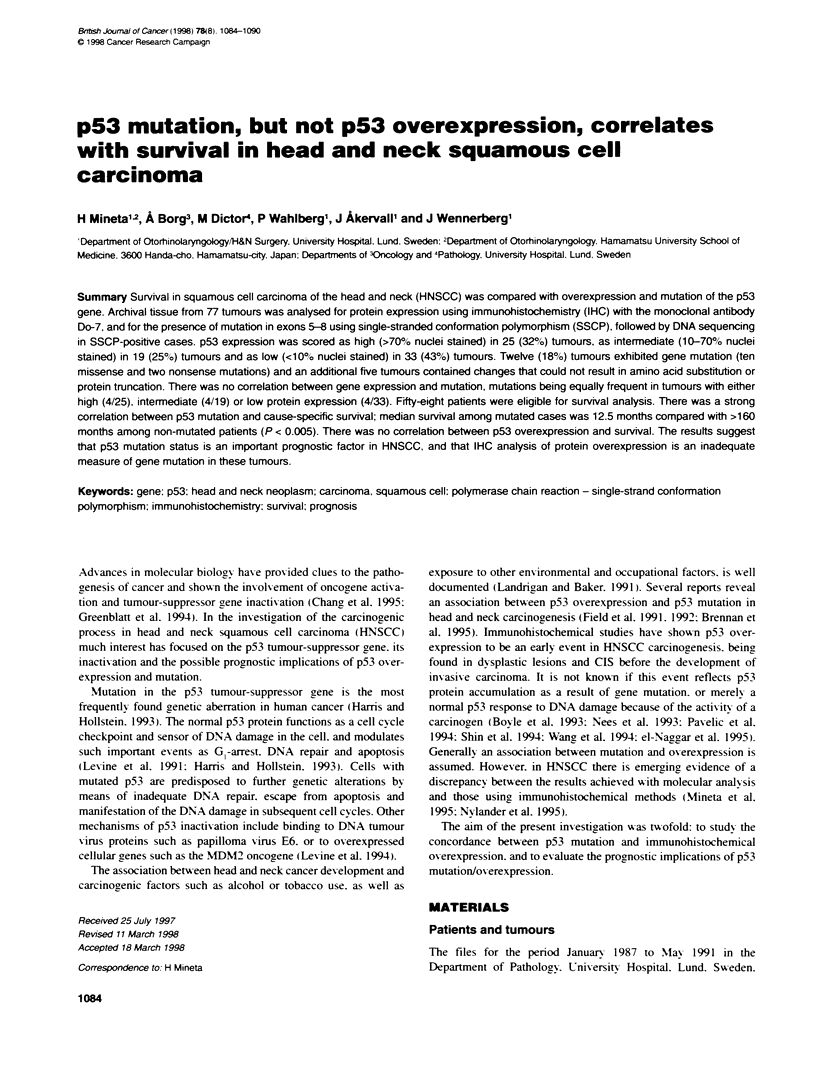
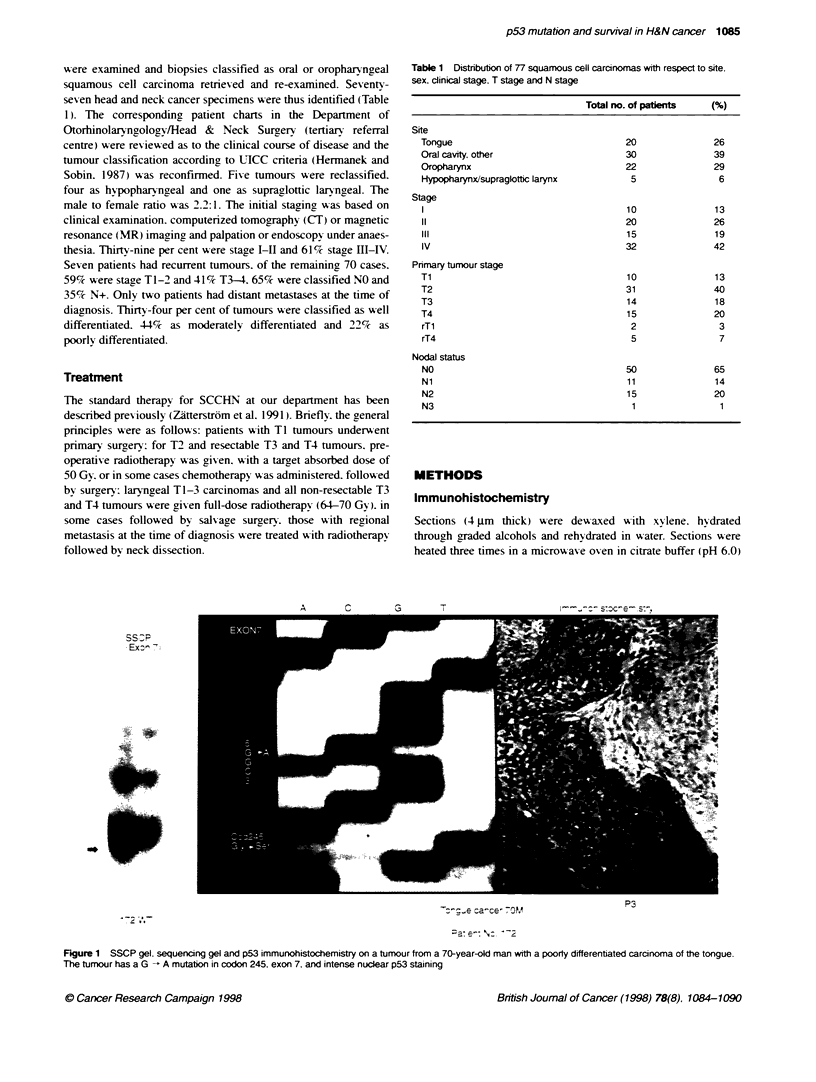
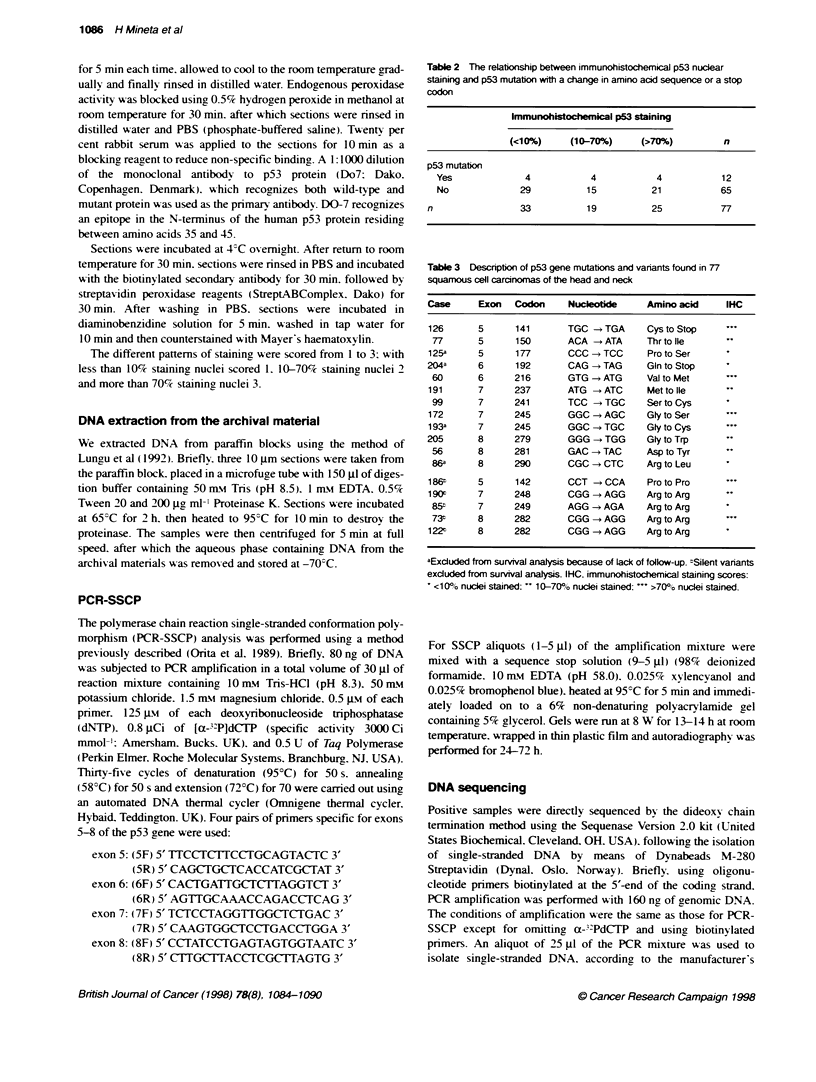
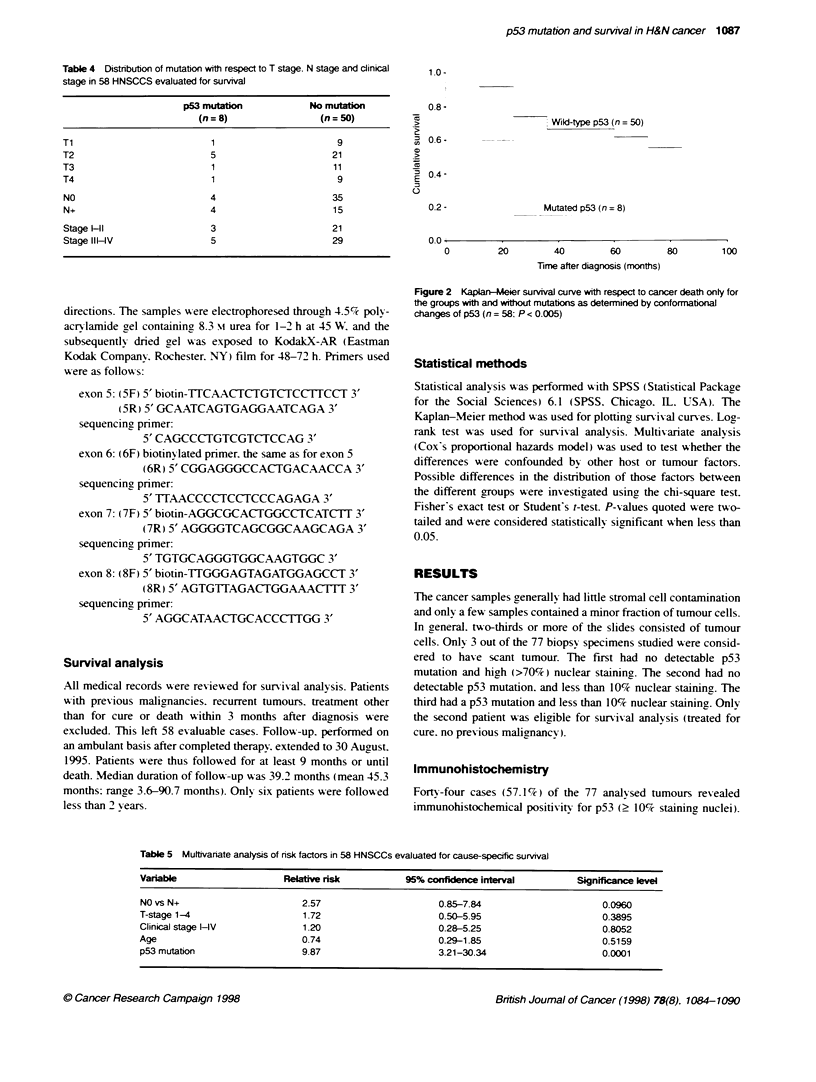
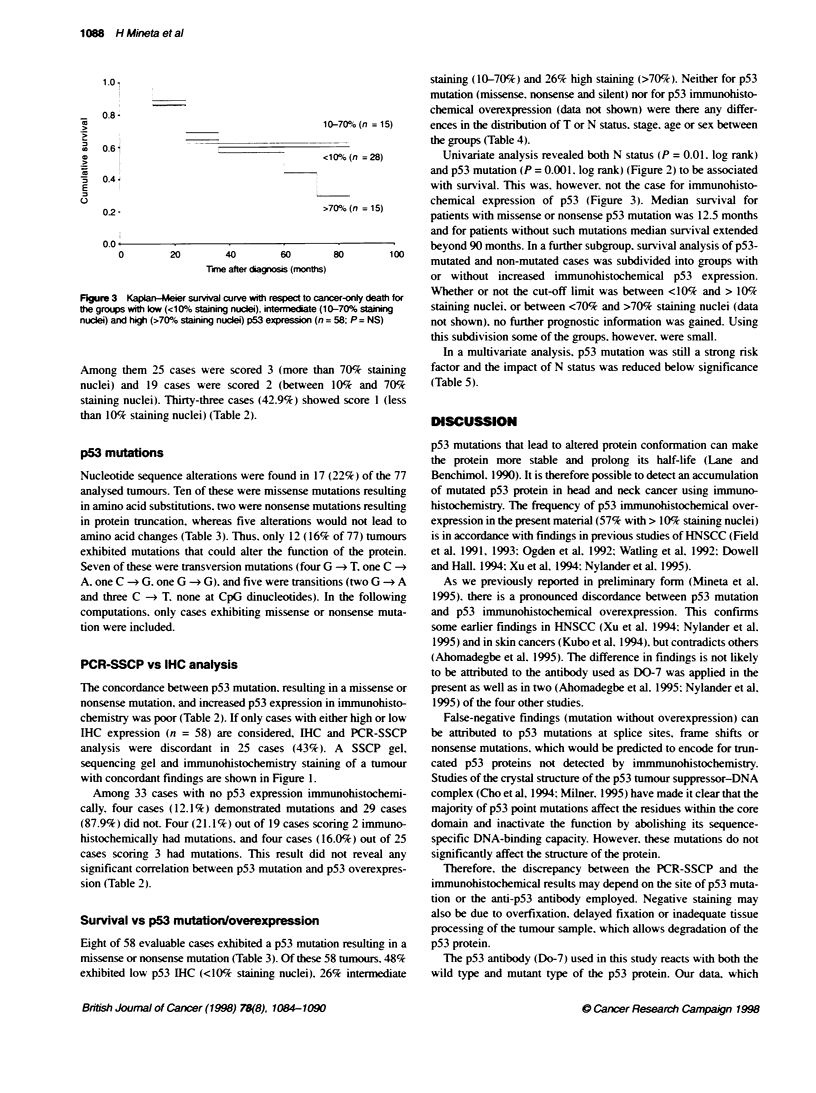
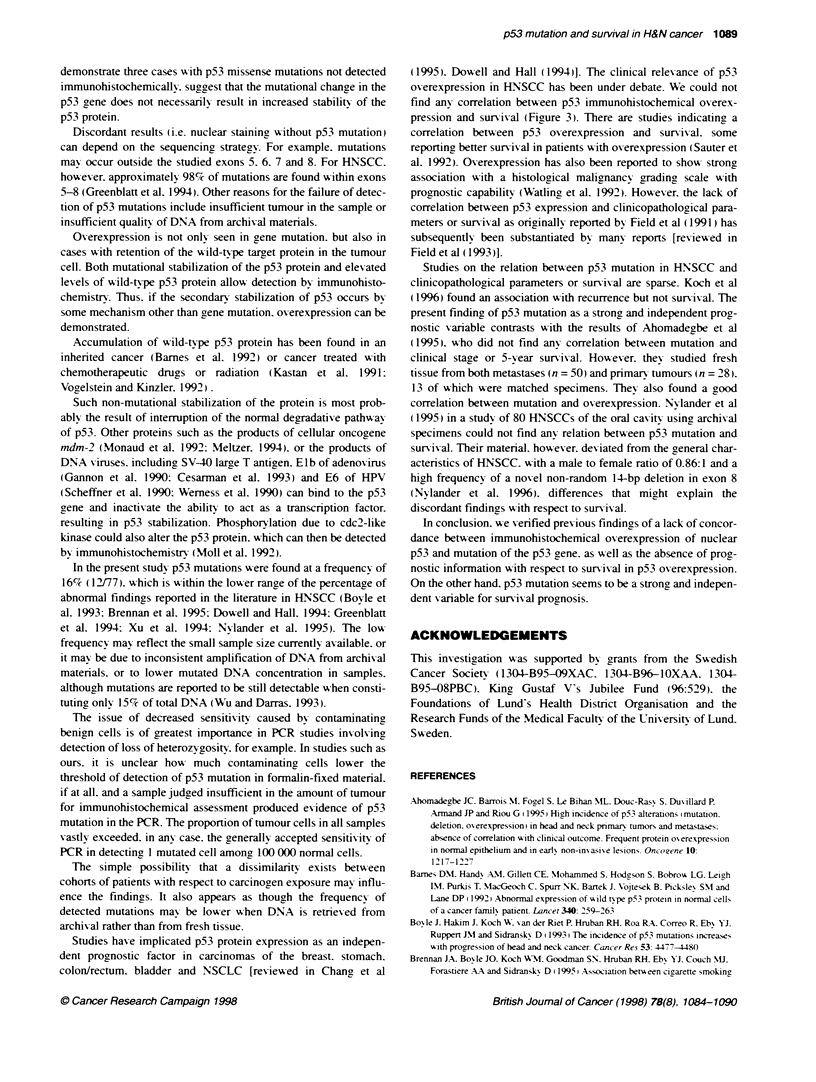
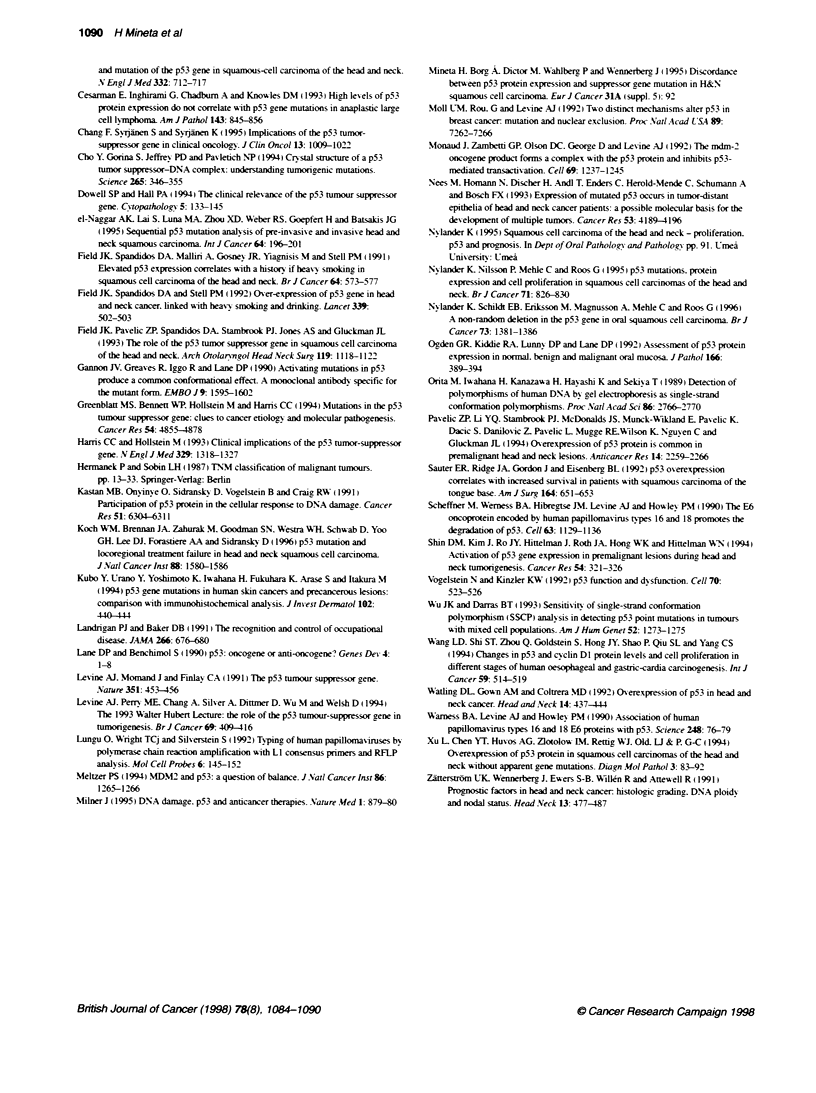
Images in this article
Selected References
These references are in PubMed. This may not be the complete list of references from this article.
- Barnes D. M., Hanby A. M., Gillett C. E., Mohammed S., Hodgson S., Bobrow L. G., Leigh I. M., Purkis T., MacGeoch C., Spurr N. K. Abnormal expression of wild type p53 protein in normal cells of a cancer family patient. Lancet. 1992 Aug 1;340(8814):259–263. doi: 10.1016/0140-6736(92)92354-i. [DOI] [PubMed] [Google Scholar]
- Boyle J. O., Hakim J., Koch W., van der Riet P., Hruban R. H., Roa R. A., Correo R., Eby Y. J., Ruppert J. M., Sidransky D. The incidence of p53 mutations increases with progression of head and neck cancer. Cancer Res. 1993 Oct 1;53(19):4477–4480. [PubMed] [Google Scholar]
- Cesarman E., Inghirami G., Chadburn A., Knowles D. M. High levels of p53 protein expression do not correlate with p53 gene mutations in anaplastic large cell lymphoma. Am J Pathol. 1993 Sep;143(3):845–856. [PMC free article] [PubMed] [Google Scholar]
- Chang F., Syrjänen S., Syrjänen K. Implications of the p53 tumor-suppressor gene in clinical oncology. J Clin Oncol. 1995 Apr;13(4):1009–1022. doi: 10.1200/JCO.1995.13.4.1009. [DOI] [PubMed] [Google Scholar]
- Cho Y., Gorina S., Jeffrey P. D., Pavletich N. P. Crystal structure of a p53 tumor suppressor-DNA complex: understanding tumorigenic mutations. Science. 1994 Jul 15;265(5170):346–355. doi: 10.1126/science.8023157. [DOI] [PubMed] [Google Scholar]
- Dowell S. P., Hall P. A. The clinical relevance of the p53 tumour suppressor gene. Cytopathology. 1994 Jun;5(3):133–145. doi: 10.1111/j.1365-2303.1994.tb00409.x. [DOI] [PubMed] [Google Scholar]
- Field J. K., Pavelic Z. P., Spandidos D. A., Stambrook P. J., Jones A. S., Gluckman J. L. The role of the p53 tumor suppressor gene in squamous cell carcinoma of the head and neck. Arch Otolaryngol Head Neck Surg. 1993 Oct;119(10):1118–1122. doi: 10.1001/archotol.1993.01880220064009. [DOI] [PubMed] [Google Scholar]
- Field J. K., Spandidos D. A., Malliri A., Gosney J. R., Yiagnisis M., Stell P. M. Elevated P53 expression correlates with a history of heavy smoking in squamous cell carcinoma of the head and neck. Br J Cancer. 1991 Sep;64(3):573–577. doi: 10.1038/bjc.1991.352. [DOI] [PMC free article] [PubMed] [Google Scholar]
- Field J. K., Spandidos D. A., Stell P. M. Overexpression of p53 gene in head-and-neck cancer, linked with heavy smoking and drinking. Lancet. 1992 Feb 22;339(8791):502–503. doi: 10.1016/0140-6736(92)91122-o. [DOI] [PubMed] [Google Scholar]
- Gannon J. V., Greaves R., Iggo R., Lane D. P. Activating mutations in p53 produce a common conformational effect. A monoclonal antibody specific for the mutant form. EMBO J. 1990 May;9(5):1595–1602. doi: 10.1002/j.1460-2075.1990.tb08279.x. [DOI] [PMC free article] [PubMed] [Google Scholar]
- Greenblatt M. S., Bennett W. P., Hollstein M., Harris C. C. Mutations in the p53 tumor suppressor gene: clues to cancer etiology and molecular pathogenesis. Cancer Res. 1994 Sep 15;54(18):4855–4878. [PubMed] [Google Scholar]
- Harris C. C., Hollstein M. Clinical implications of the p53 tumor-suppressor gene. N Engl J Med. 1993 Oct 28;329(18):1318–1327. doi: 10.1056/NEJM199310283291807. [DOI] [PubMed] [Google Scholar]
- Koch W. M., Brennan J. A., Zahurak M., Goodman S. N., Westra W. H., Schwab D., Yoo G. H., Lee D. J., Forastiere A. A., Sidransky D. p53 mutation and locoregional treatment failure in head and neck squamous cell carcinoma. J Natl Cancer Inst. 1996 Nov 6;88(21):1580–1586. doi: 10.1093/jnci/88.21.1580. [DOI] [PubMed] [Google Scholar]
- Kubo Y., Urano Y., Yoshimoto K., Iwahana H., Fukuhara K., Arase S., Itakura M. p53 gene mutations in human skin cancers and precancerous lesions: comparison with immunohistochemical analysis. J Invest Dermatol. 1994 Apr;102(4):440–444. doi: 10.1111/1523-1747.ep12373002. [DOI] [PubMed] [Google Scholar]
- Landrigan P. J., Baker D. B. The recognition and control of occupational disease. JAMA. 1991 Aug 7;266(5):676–680. [PubMed] [Google Scholar]
- Levine A. J., Momand J., Finlay C. A. The p53 tumour suppressor gene. Nature. 1991 Jun 6;351(6326):453–456. doi: 10.1038/351453a0. [DOI] [PubMed] [Google Scholar]
- Levine A. J., Perry M. E., Chang A., Silver A., Dittmer D., Wu M., Welsh D. The 1993 Walter Hubert Lecture: the role of the p53 tumour-suppressor gene in tumorigenesis. Br J Cancer. 1994 Mar;69(3):409–416. doi: 10.1038/bjc.1994.76. [DOI] [PMC free article] [PubMed] [Google Scholar]
- Lungu O., Wright T. C., Jr, Silverstein S. Typing of human papillomaviruses by polymerase chain reaction amplification with L1 consensus primers and RFLP analysis. Mol Cell Probes. 1992 Apr;6(2):145–152. doi: 10.1016/0890-8508(92)90059-7. [DOI] [PubMed] [Google Scholar]
- Meltzer P. S. MDM2 and p53: a question of balance. J Natl Cancer Inst. 1994 Sep 7;86(17):1265–1266. doi: 10.1093/jnci/86.17.1265. [DOI] [PubMed] [Google Scholar]
- Milner J. DNA damage, p53 and anticancer therapies. Nat Med. 1995 Sep;1(9):879–880. doi: 10.1038/nm0995-879. [DOI] [PubMed] [Google Scholar]
- Moll U. M., Riou G., Levine A. J. Two distinct mechanisms alter p53 in breast cancer: mutation and nuclear exclusion. Proc Natl Acad Sci U S A. 1992 Aug 1;89(15):7262–7266. doi: 10.1073/pnas.89.15.7262. [DOI] [PMC free article] [PubMed] [Google Scholar]
- Momand J., Zambetti G. P., Olson D. C., George D., Levine A. J. The mdm-2 oncogene product forms a complex with the p53 protein and inhibits p53-mediated transactivation. Cell. 1992 Jun 26;69(7):1237–1245. doi: 10.1016/0092-8674(92)90644-r. [DOI] [PubMed] [Google Scholar]
- Nees M., Homann N., Discher H., Andl T., Enders C., Herold-Mende C., Schuhmann A., Bosch F. X. Expression of mutated p53 occurs in tumor-distant epithelia of head and neck cancer patients: a possible molecular basis for the development of multiple tumors. Cancer Res. 1993 Sep 15;53(18):4189–4196. [PubMed] [Google Scholar]
- Nylander K., Nilsson P., Mehle C., Roos G. p53 mutations, protein expression and cell proliferation in squamous cell carcinomas of the head and neck. Br J Cancer. 1995 Apr;71(4):826–830. doi: 10.1038/bjc.1995.159. [DOI] [PMC free article] [PubMed] [Google Scholar]
- Nylander K., Schildt E. B., Eriksson M., Magnusson A., Mehle C., Roos G. A non-random deletion in the p53 gene in oral squamous cell carcinoma. Br J Cancer. 1996 Jun;73(11):1381–1386. doi: 10.1038/bjc.1996.262. [DOI] [PMC free article] [PubMed] [Google Scholar]
- Ogden G. R., Kiddie R. A., Lunny D. P., Lane D. P. Assessment of p53 protein expression in normal, benign, and malignant oral mucosa. J Pathol. 1992 Apr;166(4):389–394. doi: 10.1002/path.1711660411. [DOI] [PubMed] [Google Scholar]
- Orita M., Iwahana H., Kanazawa H., Hayashi K., Sekiya T. Detection of polymorphisms of human DNA by gel electrophoresis as single-strand conformation polymorphisms. Proc Natl Acad Sci U S A. 1989 Apr;86(8):2766–2770. doi: 10.1073/pnas.86.8.2766. [DOI] [PMC free article] [PubMed] [Google Scholar]
- Pavelic Z. P., Li Y. Q., Stambrook P. J., McDonald J. S., Munck-Wikland E., Pavelic K., Dacic S., Danilovic Z., Pavelic L., Mugge R. E. Overexpression of p53 protein is common in premalignant head and neck lesions. Anticancer Res. 1994 Sep-Oct;14(5B):2259–2266. [PubMed] [Google Scholar]
- Sauter E. R., Ridge J. A., Gordon J., Eisenberg B. L. p53 overexpression correlates with increased survival in patients with squamous carcinoma of the tongue base. Am J Surg. 1992 Dec;164(6):651–653. doi: 10.1016/s0002-9610(05)80727-5. [DOI] [PubMed] [Google Scholar]
- Scheffner M., Werness B. A., Huibregtse J. M., Levine A. J., Howley P. M. The E6 oncoprotein encoded by human papillomavirus types 16 and 18 promotes the degradation of p53. Cell. 1990 Dec 21;63(6):1129–1136. doi: 10.1016/0092-8674(90)90409-8. [DOI] [PubMed] [Google Scholar]
- Shin D. M., Kim J., Ro J. Y., Hittelman J., Roth J. A., Hong W. K., Hittelman W. N. Activation of p53 gene expression in premalignant lesions during head and neck tumorigenesis. Cancer Res. 1994 Jan 15;54(2):321–326. [PubMed] [Google Scholar]
- Vogelstein B., Kinzler K. W. p53 function and dysfunction. Cell. 1992 Aug 21;70(4):523–526. doi: 10.1016/0092-8674(92)90421-8. [DOI] [PubMed] [Google Scholar]
- Wang L. D., Shi S. T., Zhou Q., Goldstein S., Hong J. Y., Shao P., Qiu S. L., Yang C. S. Changes in p53 and cyclin D1 protein levels and cell proliferation in different stages of human esophageal and gastric-cardia carcinogenesis. Int J Cancer. 1994 Nov 15;59(4):514–519. doi: 10.1002/ijc.2910590414. [DOI] [PubMed] [Google Scholar]
- Watling D. L., Gown A. M., Coltrera M. D. Overexpression of p53 in head and neck cancer. Head Neck. 1992 Nov-Dec;14(6):437–444. doi: 10.1002/hed.2880140603. [DOI] [PubMed] [Google Scholar]
- Werness B. A., Levine A. J., Howley P. M. Association of human papillomavirus types 16 and 18 E6 proteins with p53. Science. 1990 Apr 6;248(4951):76–79. doi: 10.1126/science.2157286. [DOI] [PubMed] [Google Scholar]
- Wu J. K., Ye Z., Darras B. T. Sensitivity of single-strand conformation polymorphism (SSCP) analysis in detecting p53 point mutations in tumors with mixed cell populations. Am J Hum Genet. 1993 Jun;52(6):1273–1275. [PMC free article] [PubMed] [Google Scholar]
- Xu L., Chen Y. T., Huvos A. G., Zlotolow I. M., Rettig W. J., Old L. J., Garin-Chesa P. Overexpression of p53 protein in squamous cell carcinomas of head and neck without apparent gene mutations. Diagn Mol Pathol. 1994 Jun;3(2):83–92. doi: 10.1097/00019606-199406000-00004. [DOI] [PubMed] [Google Scholar]
- Zätterström U. K., Wennerberg J., Ewers S. B., Willén R., Attewell R. Prognostic factors in head and neck cancer: histologic grading, DNA ploidy, and nodal status. Head Neck. 1991 Nov-Dec;13(6):477–487. doi: 10.1002/hed.2880130603. [DOI] [PubMed] [Google Scholar]
- el-Naggar A. K., Lai S., Luna M. A., Zhou X. D., Weber R. S., Goepfert H., Batsakis J. G. Sequential p53 mutation analysis of pre-invasive and invasive head and neck squamous carcinoma. Int J Cancer. 1995 Jun 22;64(3):196–201. doi: 10.1002/ijc.2910640309. [DOI] [PubMed] [Google Scholar]



